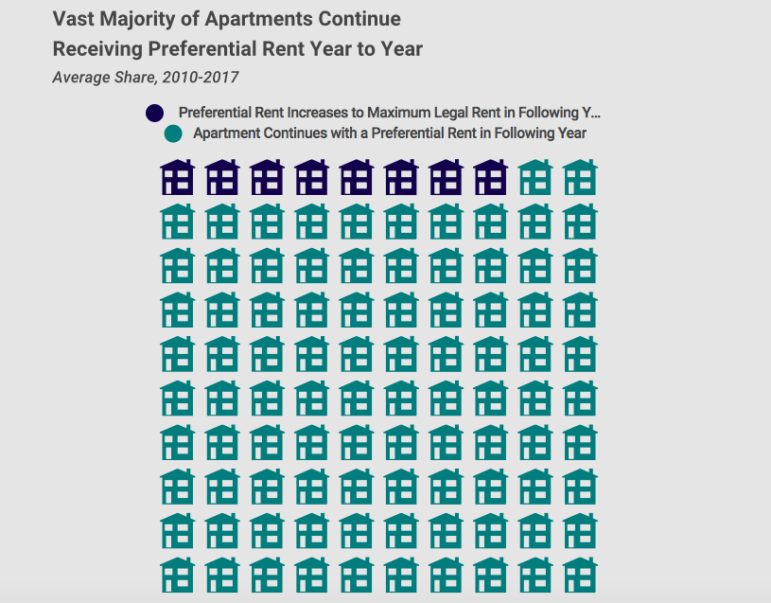
IBONYC
An image from the IBO’s report.
New York is on the verge of big changes to its rent regulations, with the state legislature likely to vote on reforms before the June 15 sunset date for the current rent law. One topic of profound disagreement between tenant advocates and property owners is preferential rents. Newly released data this week provide some important background on how those rent discounts operate.
Preferential rents occur when the landlord of a rent-stabilized apartment raises the rent less than allowed by the city’s Rent Guidelines Board (RGB), which every year decides how much of an increase to permit on the nearly 1 million stabilized apartments in the city. The most common reason for a landlord to offer a preferential rent would be because the “legal” rent on an apartment is too high to retain or attract tenants, given the market in a particular neighborhood.
In the short term, preferential rents represent a discount to tenants. But under current law, they also create the potential for a sudden hike in the rent to the full legal amount, if the landlord so decides. That could lead to a year-to-year increase in rent far exceeding the rise authorized by the RGB (which, by the way, is meeting Tuesday night for its preliminary vote on the guidelines for rents over the next year.)
Property owners believe the preferential rent issue is wholly overblown, and a little unfair: Why should their giving a short-term break to tenants be used to constrain their ability to maximize revenue within the regulations when the time comes?
Tenant advocates counter that a soft market in one year shouldn’t give landlords the ability to raise rents later by a massive amount and undermine the “stability” that a system of “rent stabilization” is supposed to create. They also worry that giving landlords that kind of pricing power equips them with a tool to push longtime tenants out (although, as the Right to Counsel coalition suggested in a report released Monday, eviction-prone landlords have other tools at their disposal).
So, how much of an issue is preferential rent in practice?
On Monday, the city’s Independent Budget Office released a brief report indicating that most apartments with preferential rent carry it from one year to the next. Over the 2010 to 2017 period, an average of 92 percent of apartments with preferential rents in one year maintained a discount in the following year.
City Limits obtained the year-to-year data, which confirm IBO’s descriptions, but hint at the beginnings of a trend that could, if sustained, change that picture.
The share of preferential rents going to the full legal rent rose in each of the last four years IBO studied. In 2017 it reached its highest percentage of the era, 10.25 percent, after a rather large jump from the previous year.
| Year | Share of apartments with preferential rent that went to the maximum rent. |
| 2010-2011 | 8.98% |
| 2011-2012 | 7.81% |
| 2012-2013 | 8.16% |
| 2013-2014 | 6.75% |
| 2014-2015 | 7.13% |
| 2015-2016 | 7.75% |
| 2016-2017 | 10.25% |
To be sure, the increased rates of conversion that IBO reported for recent years don’t appear out of step with the variation seen in earlier years, and they still affect a relatively small minority of preferential-rent apartments. However, given the growing number of apartments with preferential rents (IBO says the count increased “from about 187,500 in 2010 to nearly 266,000 in 2017”), that minority does encompass a significant number of households.
To put that number in context, the 27,265 preferential-rent apartments that went to legal rent in 2016-2017 exceeded the 24,332 affordable apartments that the mayor’s housing plan added to the stock over than same period.
IBO also found that most of the preferential-to-legal shifts occurred in Brooklyn (30 percent) or Manhattan (28 percent) but a substantial share happened in the Bronx (24 percent). That would seem to counter the argument, advanced by some property owners, that the tensions within the current rent-regulation system are confined to high-rent districts in the counties of New York and Kings.









4 thoughts on “How Often do Preferential Rents Rise? Rarely, But More Than They Used To”
The main reason the landlords have taken away preferential rent is because the city has given us a 3% increase in rents over the last 4 years where they have raised taxes over 20%. The taxes have gone up more in most of the buildings we manage than the increases the city has allotted us and the only way to come close to staying even is to take away preferential rents.
Tenants are forced out of their homes not only when landlords raise preferential rents to legal rents. Tenants more often lose their homes when landlords significantly raise a preferential rent, even if it’s still below the so-called legal rent. This article ignores that entirely.
That’s a very good point. The IBO data only covered preferential-to-legal increases, not hikes that fall short of the legal rent.
Pingback: Report: RGB gives nod to rent increase; final vote coming June 25 ⋆ New York city blog